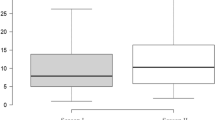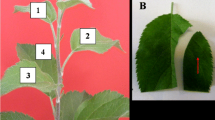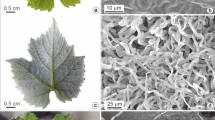Abstract
Disease symptoms and total soluble phenolics content have been analysed in four sunflower (Helianthus annuus L.)lines with different resistance levels(from highly susceptible to resistant) to head rot caused by Sclerotinia sclerotiorum (Lib.) de Bary. At the beginning of the flowering stage, capitula were inoculated by spraying with a water suspension of ascospores, and disease symptoms were evaluated from day 6 to day14 after inoculation. The most susceptible genotypes showed all their ovaries to be necrosed and abundant lesions in corollas, bracts and receptacle. In the resistant line, the ovary and corolla were only partially necrosed with no symptoms in the bracts or the receptacle. Total soluble phenolics were extracted and quantified from different parts of the capitulum in both inoculated and non-inoculated plants. The amount of phenolic compounds depended on the sunflower line, the time after inoculation, and the tissue. Higher constitutive and induced phenolic content as well as phenylalanine ammonia-lyase activity were present in the most resistant line, these differences correlated with the absence/presence of disease symptoms.
Similar content being viewed by others
References
Bazzalo, M.E., E.M. Herber & O.H. Caso, 1987. Factores fisicos y localizacion anatomica de compuestos fenólicos en relacion con la tolerancia del tallo del girasol (Helianthus annus) frente a Sclerotinia sclerotiorum, causal de la podredumbre basal. Bol Soc Bot Arg 25: 197-212.
Bazzalo, M.E., E.M. Heber, M.A. De Pero Martinez & O.H. Caso, 1985. Phenolics compounds in stems of sunflower plants inoculated with Sclerotinia sclerotiorum and their inhibitory effects on the fungus. Phytopatol Z 112: 322-332
Bazzalo, M.E. P. DiMarco, F. Martinez & G.R. Daleo, 1991. Indicators of resistance of sunflower plant to basalt stalk rot (Sclerotinia sclerotiorum): Symptomatological, biochemical, anatomical, and morphological characters of the host. Euphytica 57: 195-205
Bevan, M., D. Shufflebottom, K. Edwards, R. Jefferson & W. Schuch, 1989. Tissue and cell specific activity of phenylalanine ammonia-lyase promoter in transgenic plants. EMBO J 8: 1899-1906.
Castaño, F., F. Vear & D. Tourvieille, 2001. The genetics of resistance in sunflower capitula to Sclerotinia sclerotiorum measured by mycelium infection combined with ascospore tests. Euphytica 122: 373-380.
Friend, J., 1977. Phenolic substances and plant disease. In: T. Swain, J. Harbone & Ch. Van Sumere (Eds.), Recent Advances in Phytochemistry, Vol. 12 Biochemistry of Plants Phenolics, pp. 557-588. Plenum Press, New York.
Giudici, A.M., M.C. Regente & L. De la Canal, 2000. A potent antifungal protein from Helianthus annuus flowers is a trypsin inhibitor. Plant Physiol Biochem 38: 881-888.
Gulya, T.J., 1985. Registration of five disease-resistance sunflower germoplasms. Crop Sci 25: 719-720.
Gutiérrez-Mellado, M.C., R. Edwards, M. Tena, F. Cabello, K. Serghini & J. Jorrín, 1996. The production of coumarin phytoalexins in different plant organs of sunflower (Helianthus annuus L.). J Plant Physiol 149: 261-266.
Hemery-Tardin, M.C., D. Tourvieille de Labrouche, M. Jay, G. Ledoigt & F. Vear, 1998. Effect of infection by Sclerotinia spp. on the phenolic metabolism of sunflower capitula and leaves. Helia 21: 19-32.
Jorrín, J. & E. Prats, 1999. Allelochemicals, phytoalexins and insect-feeding deterrents: different definitions for 7-hydroxylated coumarins. In: F.A. Macías, J.C.G. Galindo, J.M.G. Molinillo & H.G. Cutler (Eds.), Recent Advances in Allelopathy-Volume I-A Science for the Future, pp. 179-192. Servicio de Publicaciones de la Universidad de Cádiz.
Jorriín, J. & R.A. Dixon, 1990. Purification, characterization and induction of phenylalanine ammonia-lyase isoform from elicitortreated cell suspension cultures. Plant Physiol 92: 447-455.
López-Valbuena, R., 1980. Efectos del mildiu (Plasmopara halstedii) en el metabolismo de compuestos fenólicos en girasol. Tesis Doctoral. Universidad de Córdoba, España.
Mazeyrat, F., S. Muuzeyar, I. Courbou, S. Badaoui, P. Roeckeldrevet, D.T. Tourvielle & G. Ledoigt, 1999. Accumulation of defense-related transcripts in sunflower hypocotyls (Helianthus annuus L.) infected with Plasmopara halstedii. Eur J Plant Pathol 105: 333-340.
Mondolot-Cosson, L., C. Andary, G. Day & J. Roussel, 1997. Histolocalisation de subtances phenoliques intervenant lor d'interaction plante-pathogène chez le tournesol et la vigne. Acta Bot Gall 144: 353-362.
Nicholson, R., & R. Hammerschmidt, 1992. Phenolic compounds and their role in disease resistance. Annu Rev Phytopathol 30: 369-389.
Pedrosa, M.M., M. Muzquiz, C. García-Vallejo, C. Burbano, C. Cuadrado, G. Ayet & L.M. Robredo, 2000. Determination of caffeic and chlorogenic acids and their derivatives in different sunflower seeds. J Sci Food Agric 80: 459-464.
Pereira, L.F., P.H. Goodwin & L. Erickson, 1999. The role of phenylalanine ammonia-lyase gene during Cassava bacterial blight and Cassava bacterial necrosis. J Plant Res 112: 51-60.
Prats, E., D. Rubiales & J. Jorrín, 2002. Acibenzolar-s-methylinduced resistance to sunflower rust (Puccinia helianthi) is associated with an enhancement of coumarins on foliar surface. Physiol Mol Plant Pathol 60: 155-162
Purdy, L.H., 1979 History, disease and symptomatology, host range, geographic distribution and impact. Symposium on Sclerotinia taxonomy, biology and pathology. Phytopathology 69: 875-880.
Says-Lesage, V. & D. Tourvielle, 1988. Reserche des sites de pollution et dïinfection des fleurons de tournesol, in situ, par les spores de Sclerotinia sclerotiorum. Informations Techniques C.E.T.I.O.M. 102: 3-13.
Serghini, K., A. Perez de Luque, M. Castjón-Muñoz, L. García-Torres, & J.V. Jorrín, 2001. Sunflower (Helianthus annuus L.) response to broomrape (Orobanche cernua Loefl.) parasitism: induced synthesis and excretion of 7-hydroxylated simple coumarins. J Exp Bot 52: 2227-2234.
Tena, M. & R. Lopez-Valvuena, 1983. Increase in phenylalanine ammonia-lyase activity caused by Plasmopara halstedii in sunflower seedlings resistant and susceptible to downy mildew. Phytopathology 107: 47-56.
Tourvieille, D., L. Mondolot-Cosson, P. Walser, C. Andary & H. Serieys, 1997. Relation entre teneurs en derives cafeolyquiniques des feuilles et la resistance de Helianthus spp. a Sclerotinia sclerotiorum. Helia 20: 39-50.
Urdangarin, C., M.C. Regente, J. Jorrín & L. de la Canal, 1999. Sun-flower coumarin phytoalexins inhibit the growth of the virulent pathogen Sclerotinia sclerotiorum. J Phytopathol 147: 441-443.
Author information
Authors and Affiliations
Rights and permissions
About this article
Cite this article
Prats, E., Bazzalo, M., León, A. et al. Accumulation of soluble phenolic compounds in sunflower capitula correlates with resistance to Sclerotinia sclerotiorum . Euphytica 132, 321–329 (2003). https://doi.org/10.1023/A:1025046723320
Issue Date:
DOI: https://doi.org/10.1023/A:1025046723320




